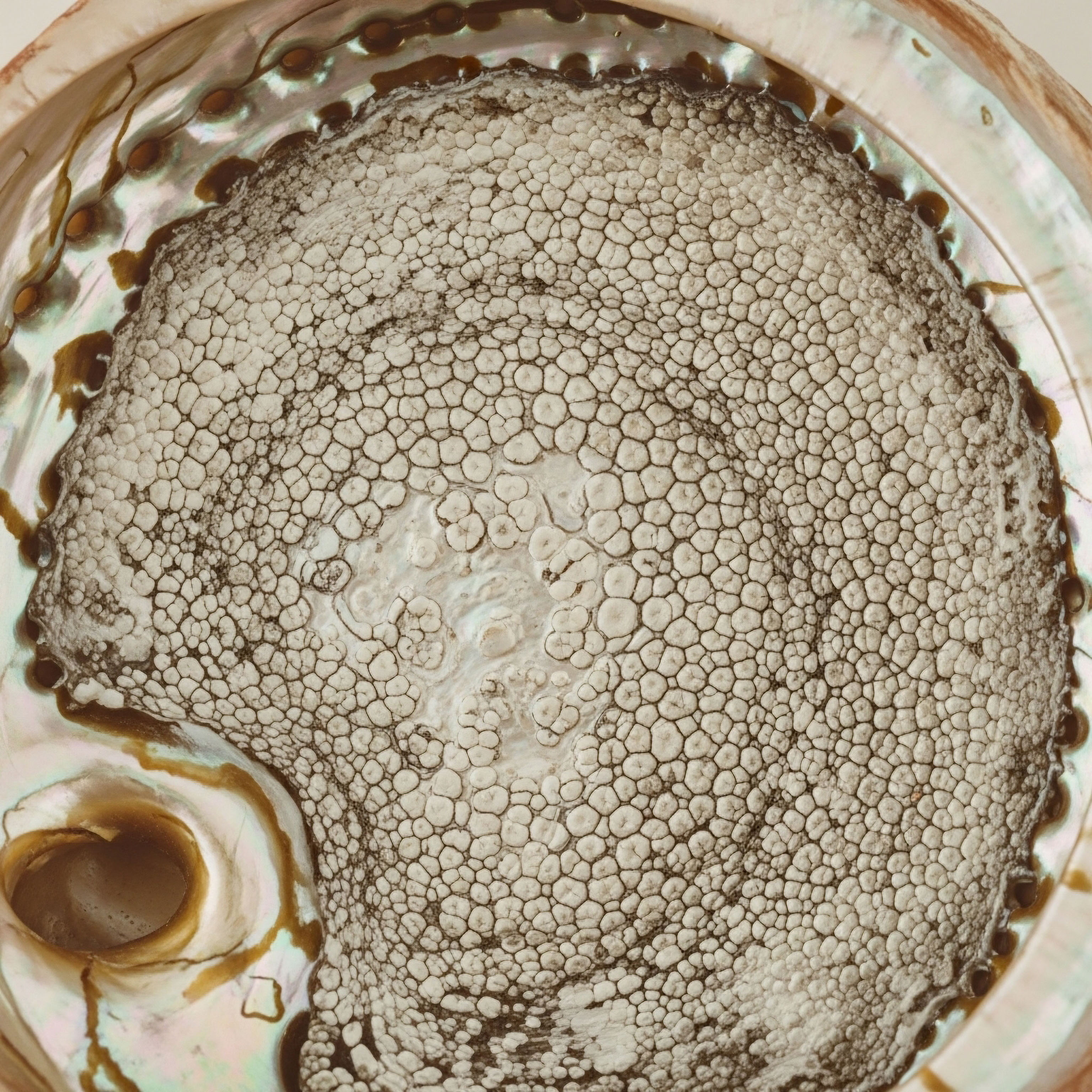

Fundamentals
Many individuals experience a subtle yet persistent decline in their overall well-being as they navigate life’s passages. Perhaps you recognize this sensation ∞ a persistent fatigue, a diminished zest for daily activities, or a sense that your body simply operates with less efficiency than before.
These changes, often dismissed as inevitable aspects of aging or the pressures of modern life, frequently signal a deeper physiological narrative unfolding within your endocrine system. Understanding these internal shifts offers a profound opportunity for reclaiming vitality.
Hormones serve as the body’s intricate internal messaging service, orchestrating countless biological processes from metabolism and mood to energy production and reproductive function. Their precise balance maintains a symphony of health. When this delicate equilibrium falters, even marginally, the downstream effects can ripple throughout every system, leading to the symptoms many individuals experience.
Hormones function as the body’s internal messaging system, influencing everything from energy and mood to metabolic regulation.

The Body’s Silent Messengers
The endocrine system comprises a network of glands that produce and secrete these potent chemical messengers directly into the bloodstream. Each hormone possesses a specific role, binding to receptors on target cells to elicit particular responses.
Consider testosterone, for instance, a hormone recognized for its role in muscle mass and libido, yet it also significantly impacts bone density, cognitive function, and cardiovascular health in both men and women. Estrogen and progesterone, similarly, extend their influence far beyond reproductive organs, affecting brain function, bone maintenance, and mood stability.
These hormonal fluctuations can arise from various factors, including the natural aging process, chronic stress, environmental exposures, and underlying health conditions. The body’s capacity to produce and regulate hormones can gradually diminish, or the sensitivity of its cells to these hormones may change. Recognizing these biochemical realities marks the initial step toward addressing the root causes of diminished well-being.

Foundational Wellness and Endocrine Resilience
Standard lifestyle interventions, encompassing balanced nutrition, consistent physical activity, adequate sleep, and effective stress management, undeniably form the bedrock of health. These practices support the body’s inherent capacity for self-regulation and optimize foundational physiological processes. A nutrient-dense diet provides the building blocks for hormone synthesis, while regular exercise enhances insulin sensitivity and cardiovascular health, indirectly supporting endocrine function.
Sufficient rest allows for cellular repair and hormonal rhythm restoration, and stress reduction mitigates the disruptive effects of cortisol on other hormonal axes.
These interventions cultivate endocrine resilience, helping the body maintain balance under normal physiological demands. For many, these strategies offer substantial improvements in energy, mood, and overall function. Yet, for others, despite diligent adherence to healthy lifestyle practices, persistent symptoms indicate a deeper, more specific imbalance. This distinction underscores the limitations of generalized approaches when confronting complex, individualized biochemical needs.


Intermediate
For individuals whose commitment to lifestyle interventions yields only partial relief, or whose symptoms point to more significant endocrine dysregulation, personalized hormone optimization offers a precise, targeted avenue for recalibration. This approach moves beyond general wellness strategies to directly address specific hormonal deficiencies or imbalances identified through comprehensive clinical assessment. The focus shifts to a biochemical restoration, where specific therapeutic agents are introduced to re-establish optimal endocrine signaling.
Personalized hormone optimization directly addresses specific hormonal imbalances through targeted therapeutic interventions, moving beyond generalized lifestyle adjustments.

Precision Endocrine Recalibration
Personalized hormone optimization distinguishes itself through its individualized nature. It begins with an extensive evaluation, including detailed symptom analysis, a thorough medical history, and advanced laboratory testing to ascertain current hormone levels and related biomarkers. This diagnostic clarity permits healthcare providers to formulate a therapeutic strategy uniquely suited to the individual’s physiological blueprint.
The goal involves restoring hormone levels to an optimal physiological range, rather than merely within a “normal” population average, which may still leave many individuals symptomatic. This precision reflects a commitment to the individual’s subjective experience of well-being, validated by objective data.
The therapeutic modalities employed in personalized hormone optimization often mirror the body’s own biochemistry, utilizing bioidentical hormones that are structurally identical to those naturally produced. This molecular congruence facilitates seamless integration into existing biological pathways, minimizing potential adverse reactions. The method of administration, dosage, and specific compounds are meticulously selected based on the individual’s unique needs, ensuring a tailored approach to biochemical restoration.

Targeted Therapeutic Modalities
A range of clinical protocols falls under the umbrella of personalized hormone optimization, each designed to address specific endocrine needs. These protocols offer distinct mechanisms of action and targeted outcomes.

Testosterone Support Protocols
For men experiencing symptoms associated with declining testosterone, such as diminished libido, persistent fatigue, reduced muscle mass, or mood alterations, Testosterone Replacement Therapy (TRT) provides a direct intervention. A standard protocol frequently involves weekly intramuscular injections of Testosterone Cypionate, aiming to restore serum testosterone levels to a healthy, youthful range.
To support endogenous testosterone production and fertility, Gonadorelin may be administered subcutaneously, often twice weekly. Anastrozole, an aromatase inhibitor, finds application in mitigating the conversion of testosterone to estrogen, thereby reducing potential side effects. Some protocols may also incorporate Enclomiphene to selectively stimulate luteinizing hormone (LH) and follicle-stimulating hormone (FSH) levels, further supporting testicular function.
Women, too, can experience the impact of suboptimal testosterone levels, particularly during peri- and post-menopause, manifesting as low libido, reduced energy, and cognitive shifts. Testosterone Cypionate, administered weekly via subcutaneous injection at lower doses (e.g. 0.1 ∞ 0.2 ml), helps restore balance. Progesterone supplementation is often integrated, particularly for women with an intact uterus, to ensure uterine health and broader hormonal synergy. Pellet therapy, offering a sustained release of testosterone, presents another viable option, sometimes combined with Anastrozole when clinically indicated.

Peptide Bioregulators
Growth Hormone Peptide Therapy represents another sophisticated avenue for enhancing metabolic function, cellular repair, and overall vitality. Peptides such as Sermorelin, Ipamorelin, and CJC-1295 function as Growth Hormone Secretagogues (GHSs), stimulating the body’s natural production and release of growth hormone. These agents offer benefits spanning improved body composition, enhanced sleep quality, increased energy, and accelerated recovery, appealing to active adults and those seeking anti-aging benefits.
Other specialized peptides target specific physiological processes:
- PT-141 ∞ This peptide, also known as Bremelanotide, addresses sexual health by acting on melanocortin receptors in the central nervous system, enhancing libido and arousal in both men and women.
- Pentadeca Arginate (PDA) ∞ BPC-157, a gastric pentadecapeptide, facilitates tissue repair, accelerates wound healing, and reduces inflammation through mechanisms involving angiogenesis and cellular turnover. It supports gut health and aids in recovery from physical stressors.
The table below delineates the distinct focus of lifestyle interventions versus personalized hormone optimization:
| Aspect | Standard Lifestyle Interventions | Personalized Hormone Optimization |
|---|---|---|
| Primary Goal | Establish foundational health and systemic resilience. | Precisely restore optimal hormonal balance and function. |
| Approach | Generalized recommendations for diet, exercise, sleep, stress. | Individualized protocols based on specific lab data and symptoms. |
| Mechanism | Supports natural physiological processes indirectly. | Directly modulates endocrine pathways with targeted agents. |
| Intervention Type | Behavioral changes, nutritional support, physical activity. | Bioidentical hormones, specific peptides, pharmaceutical compounds. |
| Outcome | Broad improvements in general well-being, disease prevention. | Specific symptom resolution, enhanced physiological function, vitality. |


Academic
A deeper examination of personalized hormone optimization necessitates a systems-biology perspective, moving beyond isolated hormonal deficiencies to consider the intricate feedback loops and metabolic interdependencies that govern endocrine function. The efficacy of targeted interventions hinges upon a sophisticated understanding of how exogenous hormones and peptide bioregulators interact with endogenous signaling pathways, ultimately influencing cellular physiology and overall well-being. This complex interplay reveals the nuanced difference between broad physiological support and precise biochemical recalibration.

The Hypothalamic-Pituitary-Gonadal Axis Unveiled
The Hypothalamic-Pituitary-Gonadal (HPG) axis orchestrates reproductive function and influences numerous systemic processes through a cascade of neuroendocrine signals. Gonadotropin-releasing hormone (GnRH), secreted pulsatilely from the hypothalamus, stimulates the anterior pituitary to release luteinizing hormone (LH) and follicle-stimulating hormone (FSH).
These gonadotropins, in turn, act upon the gonads ∞ testes in men and ovaries in women ∞ to promote gamete production and sex steroid synthesis, including testosterone, estradiol, and progesterone. These gonadal steroids then exert negative feedback on the hypothalamus and pituitary, maintaining homeostatic control.
In the context of male Testosterone Replacement Therapy (TRT), exogenous testosterone administration directly suppresses GnRH release, leading to a reduction in endogenous LH and FSH, and consequently, a decrease in intratesticular testosterone production. This exogenous input bypasses the natural feedback mechanisms.
Protocols incorporating Gonadorelin, a synthetic GnRH analogue, aim to mitigate this suppression by stimulating pulsatile LH and FSH release, thereby preserving testicular function and spermatogenesis. Anastrozole, an aromatase inhibitor, acts by blocking the conversion of androgens to estrogens, a process primarily mediated by the aromatase enzyme, particularly in adipose tissue. Elevated estrogen levels in men can contribute to gynecomastia, fluid retention, and mood disturbances, thus necessitating careful management to maintain an optimal androgen-to-estrogen ratio.

Androgenic Signaling and Metabolic Homeostasis
Testosterone’s influence extends far beyond its reproductive roles, impacting metabolic homeostasis, cardiovascular health, and neurocognitive function. Androgen receptors, distributed throughout various tissues, mediate these diverse effects. In muscle tissue, testosterone promotes protein synthesis and lean body mass accrual, while in adipose tissue, it contributes to fat metabolism and distribution.
Evidence suggests a correlation between optimal testosterone levels and improved insulin sensitivity, reduced visceral adiposity, and a favorable lipid profile, underscoring its role in mitigating metabolic syndrome risk. Therefore, personalized testosterone optimization involves not only symptom amelioration but also a strategic intervention for long-term metabolic health.

Molecular Choreography of Peptide Therapies
Peptide therapies offer a sophisticated means of modulating specific physiological pathways with high specificity and a favorable safety profile. Growth Hormone Secretagogues (GHSs), such as Sermorelin, Ipamorelin, and CJC-1295, function by binding to the ghrelin receptor (GHS-R1a) or by acting as growth hormone-releasing hormone (GHRH) analogues.
These actions stimulate the somatotroph cells in the anterior pituitary to release endogenous growth hormone (GH). This pulsatile, physiological release pattern differs from direct exogenous GH administration, which can suppress the body’s natural production. The downstream effects of increased GH include elevated insulin-like growth factor 1 (IGF-1) levels, which mediate many of GH’s anabolic and regenerative properties.

Somatotropic Axis and Cellular Longevity
The somatotropic axis, comprising GH and IGF-1, plays a pivotal role in cellular repair, tissue regeneration, and metabolic regulation. Optimal function of this axis contributes to improved body composition (reduced fat mass, increased lean muscle mass), enhanced bone mineral density, improved sleep architecture, and neuroprotective effects.
Peptide bioregulators precisely target this axis, promoting a more youthful physiological environment at a cellular level. For example, Ipamorelin selectively stimulates GH release with minimal impact on other pituitary hormones like cortisol and prolactin, offering a cleaner physiological signal.
Other targeted peptides demonstrate remarkable specificity. PT-141 (Bremelanotide) functions as a melanocortin receptor agonist, primarily activating MC3R and MC4R receptors in the central nervous system. This activation leads to a modulation of dopaminergic pathways involved in sexual arousal, offering a unique, non-vascular mechanism for addressing sexual dysfunction in both men and women.
BPC-157, a stable gastric pentadecapeptide, exerts its therapeutic effects through various mechanisms, including promoting angiogenesis (formation of new blood vessels), modulating growth factor expression (e.g. VEGF, FGF), and enhancing fibroblast and collagen production. These actions collectively accelerate tissue healing, reduce inflammation, and protect organ systems, particularly within the gastrointestinal tract and musculoskeletal system.
A comprehensive understanding of these molecular mechanisms allows for the precise application of personalized hormone optimization, moving beyond symptomatic relief to address underlying physiological dysfunctions. The table below outlines key biomarkers and their clinical significance in assessing endocrine health:
| Biomarker | Clinical Significance | Relevance to Optimization |
|---|---|---|
| Total Testosterone | Overall androgen status, impacts libido, energy, muscle mass, mood. | Primary target for TRT protocols in men and women. |
| Free Testosterone | Biologically active fraction of testosterone, more indicative of tissue availability. | Refines dosing to achieve optimal physiological effect. |
| Estradiol (E2) | Estrogen levels, important for bone health; can be elevated with TRT in men. | Monitored to prevent side effects like gynecomastia or fluid retention. |
| Sex Hormone Binding Globulin (SHBG) | Protein binding testosterone; influences free testosterone levels. | Helps interpret total testosterone and guide therapeutic adjustments. |
| Luteinizing Hormone (LH) | Pituitary signal to gonads for testosterone production. | Assesses endogenous testicular function; monitored with Gonadorelin use. |
| Follicle-Stimulating Hormone (FSH) | Pituitary signal for spermatogenesis and ovarian follicular development. | Monitored for fertility considerations and ovarian reserve. |
| Insulin-like Growth Factor 1 (IGF-1) | Mediator of growth hormone action, anabolic effects. | Evaluates efficacy of Growth Hormone Peptide Therapy. |

How Does Endocrine System Interconnectedness Influence Treatment Outcomes?
The endocrine system operates as a finely tuned orchestra, where changes in one hormone invariably affect others. For instance, optimizing testosterone levels can influence thyroid function, insulin sensitivity, and even the stress response axis (HPA axis). This interconnectedness means that a seemingly isolated hormonal imbalance often reflects a broader systemic dysregulation.
A comprehensive approach acknowledges these relationships, ensuring that interventions in one area do not inadvertently create imbalances elsewhere. Monitoring a panel of related hormones and metabolic markers, rather than focusing on a single analyte, offers a holistic view of the individual’s biochemical landscape, guiding more effective and sustainable outcomes.

Why Is Individualized Dosing Imperative for Hormonal Well-Being?
The concept of individualized dosing stems from the inherent biological variability among individuals. Genetic polymorphisms, lifestyle factors, age, and existing comorbidities all influence how a person metabolizes and responds to hormonal interventions. A “one-size-fits-all” approach risks either under-dosing, leading to persistent symptoms, or over-dosing, potentially inducing adverse effects.
Precision medicine, in this context, involves titrating dosages based on continuous clinical assessment and serial laboratory monitoring, aiming for the optimal therapeutic window that restores vitality without compromise. This iterative process ensures that the individual’s unique physiology is respected and supported throughout their journey toward hormonal well-being.

References
- Petering, Ryan C. and Nathan A. Brooks. “Testosterone Therapy ∞ Review of Clinical Applications.” American Family Physician, vol. 96, no. 7, 2017, pp. 441-449.
- Newson, Louise. “The Importance of Testosterone for Women.” Dr Louise Newson, 2024.
- Bassil, Nahla, et al. “Efficacy and Adverse Events of Testosterone Replacement Therapy in Hypogonadal Men ∞ A Systematic Review and Meta-Analysis of Randomized, Placebo-Controlled Trials.” The Journal of Clinical Endocrinology & Metabolism, vol. 98, no. 10, 2013, pp. 1050-1065.
- Harman, S. Mitchell, et al. “Testosterone Replacement Therapy in Older Men ∞ Clinical Implications of Recent Landmark Trials.” The Journal of Clinical Endocrinology & Metabolism, vol. 109, no. 8, 2024, pp. 1957-1970.
- Katznelson, L. et al. “Growth Hormone Secretagogues ∞ History, Mechanism of Action, and Clinical Development.” Growth Hormone & IGF Research, vol. 20, no. 1, 2010, pp. 1-10.
- Signore, Andrea, et al. “Orally Active Growth Hormone Secretagogues ∞ State of the Art and Clinical Perspectives.” European Journal of Endocrinology, vol. 141, no. 4, 1999, pp. 323-332.
- Mihailescu, C. and D. P. Gherasim. “A Systematic Review on the Latest Developments in Testosterone Therapy ∞ Innovations, Advances, and Paradigm Shifts.” Journal of Clinical Medicine, vol. 11, no. 19, 2022, pp. 5881.
- Narayanan, R. “Peptides and Sexual Wellness ∞ Enhancing Intimacy Through Functional Medicine.” HealthGAINS, 2025.
- Afrin, L. B. et al. “Pentadecapeptide BPC 157 ∞ A Potential Therapeutic for Tissue Repair and Regeneration.” Frontiers in Pharmacology, vol. 11, 2020, pp. 1195.
- Clarke, I. J. et al. “Emerging Insights into Hypothalamic-Pituitary-Gonadal (HPG) Axis Regulation and Interaction with Stress Signaling.” Frontiers in Endocrinology, vol. 12, 2021, pp. 687352.

Reflection
The journey toward optimal health often begins with a profound act of listening ∞ to your body’s subtle signals, to the persistent whispers of imbalance that daily life might otherwise drown out. This exploration of personalized hormone optimization is not an endpoint; it is a vital beginning.
The knowledge gained here provides a framework for understanding your own biological systems, illuminating pathways to reclaim the vitality and function you seek. Your individual path to wellness demands a personalized map, one that respects your unique physiology and validates your lived experience. Consider this understanding a powerful tool, empowering you to seek guidance that truly aligns with your body’s intrinsic needs and your aspirations for a life lived with unwavering health.



